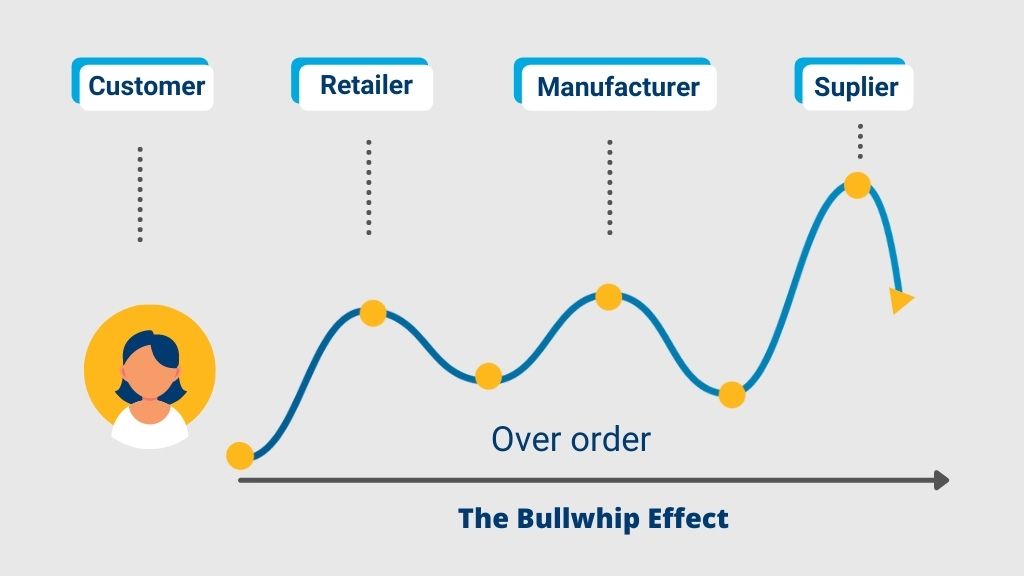

The bullwhip effect, whiplash effect or Forrester effect is a mismatch in the demand forecast that extends along the supply chain of an e-commerce business. It happens when an inaccuracy or error in the demand forecast at one point in the supply chain increases as it moves away from the end consumer. This exponential error can cause problems in the sale and distribution of different products and affect the company’s profitability. At the same time, the bullwhip effect maintains a two-way relationship with the e-commerce business’s pricing strategy. Sales prices can cause the bullwhip effect to either increase or decrease. Variations in this effect can lead to price changes. We explain in detail below.
In a more graphic example, the whip effect occurs when:
- The consumer’s demand forecast is 10 units.
- The retailer orders 15 units in case demand increases.
- The distributor orders 20 units.
- The manufacturer buys material to make 40 units to lower costs.
Result: between 1 and 10 units will be sold, and 40 units have been manufactured that will not go to the market in the short term. And the problem compounds if the difference between actual demand and available stock throughout the supply chain continues to widen month on month.
This mismatch can result from inventory problems and over-production, equipment rental overruns or extra staff hours. If the downwards estimate is wrong, it can result in a stock break that leaves the e-commerce business out of stock. It can also cause low production periods for manufacturers and logistical delays affecting end consumers. This is what happened in international trade in 2021, which led to a shortage of electronic products such as graphics cards, computers, or game consoles, such as PlayStation 5.
What is the role of pricing in the bullwhip effect?
On the one hand, price variations are factors that can lead to an increase in the bullwhip effect. In this sense, when an e-commerce business launches a special-offer campaign, demand is likely to increase based on the discount percentage. In addition, higher prices can lead customers to be more averse to purchasing products, thereby reducing demand. Therefore, it is essential to know the degree of elasticity of demand for each product. It is also necessary to maintain seamless communication with all agents in the supply chain, ensuring that they are aware of expected changes in demand.
On the other hand, in cases of stock overproduction, one way to control and reverse the bullwhip effect is to reduce items’ prices. This helps spark greater interest in retailers or end customers, depending on the location of the excess products.

Other causes of the bullwhip effect on the supply chain
In addition to prices, other causes can lead to a mismatch in the demand forecast along the supply chain. The most relevant are:
- Slow or incorrect information transfer between different agents in the supply chain.
- Creation of safety stocks inconsistent with demand level. Safety stock is the extra products ordered in anticipation of an increase in orders. Although they perform a useful function, they must mirror expected demand.
- Incorrect forecasts by one of the supply chain members.
- Unexpected high demand situations. For example, at the beginning of the Covid19 pandemic, it was impossible to predict that many consumer staples would run out.
- Lack of confidence in the accuracy of orders from other agents involved in the sale.
To avoid this, together with the necessary internal communication, it is advisable to balance inventories, avoid going from peak demand to peak demand. Standardising your pricing strategy would also help to more or less stabilise consumer behaviour. To achieve this, implement a pricing suite to set the most appropriate prices at each moment in time, based on the market’s needs, and thereby maintain your profit margin.
Find out how Minderest can take your business to the next level.
Contact our pricing experts to see the platform in action.
Related Articles

AI Agents and Holiday Season: How to Adapt Your Pricing Strategy
Holiday season planning used to revolve around creative campaigns, emotional storytelling, and optimizing the user experience. However, a silent revolution is changing the rules of the game. The rise...
How Surveillance Pricing Works and Its Applications for Your Business
The term "Surveillance Pricing" might conjure images of corporate espionage and price manipulation. However, this initial perception hides one of the most sophisticated and powerful strategies in...